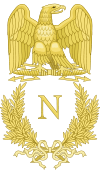Fauj-i-Ain
| Fauj-i-Ain | |
|---|---|
|
Sarkar-i-Khalsa | |
| Active | 1805–1849 |
| Country |
|
| Size |
180,000 (Total)
|
| Garrison/HQ | Peshawar garrison, Sutlej garrison, Sindh garrison, Kashmir garrison |
| Nickname | The army with the drill |
| Patron | Khalsa |
| Motto | Deg Tegh Fateh |
| Colors | Le Tricolore |
| March | La Victoire est à nous |
| Engagements | Afghan-Sikh Wars, Sino-Sikh War, Anglo-Sikh Wars |
| Commanders | |
| Notable commanders |
Hari Singh Nalwa Maharaja Ranjit Singh I of Punjab Jean-Francois Allard Jean-Baptiste Ventura |
| Insignia | |
| Identification symbol | Khanda |
The Fauj-i-Ain (Punjabi:ਫੌਜ -ਏ-ਐਨ ,Persian:فوج ی این) was the regular army of Maharaja Ranjit Singh I of Punjab. It contained infantry, cavalry and artillery units.
Background
Concerned by the growing power of the British in the Indian subcontinent, Ranjit Singh started worrying about the future of his Sikh Empire. He once met Irish adventurer George Thomas and was surprised to see the discipline and new equipment of his army. Ranjit Singh then ordered his generals to train the troops with European muskets, possibly the Brown Bess and Baker rifle. However, his generals were unsuccessful. At that time, Ranjit Singh's men did not wear uniforms, were undisciplined and used matchlocks, swords (including the talwar, khanda (sword) and shamshir), lances and bows.
Beginning
It was the Maharaja Ranjit Singh who started to hire European officers to train and command parts of his army. The Fauj-i-Khas was a model brigade trained and equipped after the European model under the command of General Jean-Baptiste Ventura.
Infantry
Ranjit Singh was fully aware of the importance of infantry. The task of recruitment in this army had started after 1805, which continued throughout his reign. In the beginning, the number of Sikhs in this army was nominal. The reason being that the Sikhs looked down upon infantry. Therefore, in the beginning, Ranjit Singh recruited some Pathans and Gurkhas in this section of his army. Afterwards, owing to Ranjit Singh's efforts, Sikhs too began to join it. In 1822, he employed General Jean-Baptiste Ventura to train the infantry in western pattern. Under his guidance, the infantry became the most disciplined army of within a few years.
By 1838-1839 the strength of the infantry had risen to 60,000. It was divided into battalions, companies and sections. Each battalion consisted of 800 soldiers. It was put under a Commandant. Each battalion was divided into eight companies. Each company was put under a Subedar. Each company was put under 4 sections. Each section consisted of 25 soldiers. It was put under a Jamadar.
Cavalry
The second most important part of the army was cavalry. In order to organize it on western lines,Ranjit Singh appointed General Jean-Francois Allard. Under his command, the cavalry became very strong . In 1838-39, the over all strength of the cavalry was 4,0090. The cavalry was divided into regiments. Each regiment consisted of 250 to 600 cavaliers. The regiments were further divided into risalas (corps). Each Risala consisted of 150 to 250 cavaliers. The officers and other non-combatants of cavalry were similar to those of infantry. The pay of the cavalry was, however higher than that of the infantry.
Artillery
Ranjit Singh I was fully aware of the importance of artillery in the modern warfare. Therefore, he paid a special attention to the development of artillery in 1810. In 1812 he employed General Claude Auguste Court and Colonel Alexander Gardner in 1832 and organized Topkhana-i-Khas. Under their able guidance the artillery made matchless progress in a few years.Ranjit Singh I divided his artillery into four categories: 1.Topkhana-i-Fili 2.Topkhana-i-Shutri 3.Topkhana-i-Aspi 4.Topkhana-i-Gavi Topkhana-i-Fili consisted of very heavy guns,which were pulled by elephants.Topkhana-i-Shutri consisted of those guns which were pulled by camels. Topkhana-i-Aspi consisted of light guns which were pulled by horses. Topkhana-i-Gavi consisted of medium guns which were pulled by the oxen.The artillery was divided into batteries or deras. Each battery consisted of 10 guns and 250 gunners. Each battery was under a Commandant. The batteries were further divided into sections. Each section compromised 2 guns and 8 to 10 gunners. Each section was under a Jamadar. The entire artillery was under a General.
